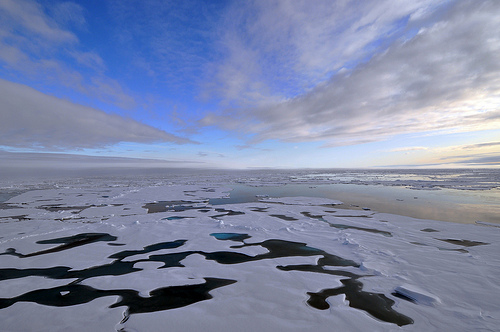 In the Arctic Ocean, Big Oil is taking bigger risks than ever before.Photo: U.S. Geological SurveyThere are clear signs that a new Arctic oil rush has begun. Earlier this month, Shell submitted plans to the U.S. government for new drilling in the icy waters off Alaska’s north coast, and now a Scottish company has won permission to take a similar gamble near Greenland. Tomorrow, Hillary Clinton will fly to the picturesque town of Nuuk in Greenland to discuss how spill response equipment might work in one of the world’s most extreme and beautiful environments. I can save her the trip — it won’t.
In the Arctic Ocean, Big Oil is taking bigger risks than ever before.Photo: U.S. Geological SurveyThere are clear signs that a new Arctic oil rush has begun. Earlier this month, Shell submitted plans to the U.S. government for new drilling in the icy waters off Alaska’s north coast, and now a Scottish company has won permission to take a similar gamble near Greenland. Tomorrow, Hillary Clinton will fly to the picturesque town of Nuuk in Greenland to discuss how spill response equipment might work in one of the world’s most extreme and beautiful environments. I can save her the trip — it won’t.
Here are some facts. Over the next few years, a handful of powerful oil companies will tow rigs beyond the Arctic Circle to drill for a few short months before the winter sea ice closes in. They’ll rely on untested equipment and wildly ambitious response plans in the event of a blowout or other major accident. When October comes, the sea ice will close in and leave the area completely isolated until the following summer.
Think about that for a moment. This means that if a blowout happened in the fall, oil could gush out underneath the ice from Halloween through Thanksgiving, all the way to Memorial Day or, depending on the oil spill and the ice, the Fourth of July or longer. Wildlife like bowhead whales, polar bears, seals, and walrusese would have to fend for themselves as the world looks on helplessly and the oil companies make their excuses. We tried. We took precautions. It’s a big ocean. The Arctic will recover. Sound familiar?
Global warming is happening faster in the Arctic than on anywhere else on Earth, and multinational oil companies are desperate to exploit the newly opened seas for huge profits. Safety is not their first priority, whatever the glossy brochures and reassuring words might say. The Deepwater Horizon disaster took 6,500 well-equipped vessels over three months to cap. In the Arctic Ocean, there aren’t even that many kayaks.
In the Arctic Ocean, the world’s last real frontier, Big Oil is taking bigger risks than ever before and dressing up their recklessness as necessity. They’re wrong. We can prevent extracting oil from the Arctic — and the Gulf of Mexico, and the tar sands in Canada — by taking it out of Detroit instead. We can “produce” millions of barrels a year simply by not using it in the first place. Cleaner cars with better engines mean lower bills, less pollution, and a healthier industry.
Our politicians have become hypnotized by the mantra of the fossil fuel lobby and are repeating it like drones — more, more, more. At some point this thirst, this reckless and desperate urge, has to stop. One day, somewhere, we must draw a line in the sand and say: enough. This year just might be the moment, and Alaska’s Arctic Ocean might be the place.



